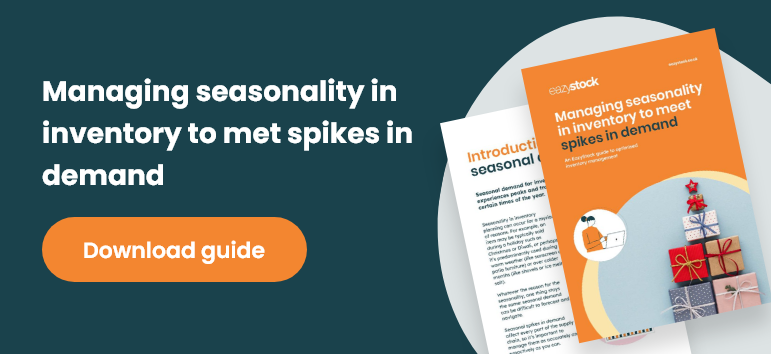What is seasonal demand forecasting, and why is it important?
Seasonal demand forecasting
Seasonal demand forecasting can often be one of the most difficult areas of your inventory management processes to master. Annoyingly, you experience the same problem every year – demand for a product will remain steady throughout the year, then suddenly without warning you’ll see orders skyrocket or plummet. Rest assured, you’re not alone in your struggles. And what’s more, we have some advice from a leading expert to help get your forecasting under control.
What is seasonal demand forecasting? A definition
Seasonal demand forecasting is how inventory teams identify and manage the peaks and troughs in demand that some items experience at certain times of the year. For example, classic gift items will see a sharp demand increase before Christmas but will then slow down soon after. While businesses may be aware of seasonal demand fluctuations, managing them can often pose a greater challenge. And, if seasonal demand is not taken into account early in the ordering cycle, it can quickly affect the entire supply chain.
To give you better insight into managing seasonal demand forecasting, we spoke with Peter Drakeley, the Head of Global Customer Success at EazyStock and one of our most experienced supply chain specialists.
Why is seasonal demand forecasting important?
Hi Peter, thanks for joining us. So let’s focus on seasonal demand forecasting and how to deal with it. Peter, why is seasonal demand management important?

Seasonality of demand can be a big issue for companies in almost any industry. It can be driven by traditions and events that influence consumer buying behavior, for example Christmas or Black Friday, when people tend to buy more. Or it can be more directly associated with the weather, such as increased sales of garden furniture during spring.
In extreme cases I have seen companies make more than 50% of their total annual sales during a short seasonal burst. So forecasting correct stock levels during this period is critical.
When a significant proportion of your sales come from intermittent seasonal peaks, you obviously need the right stock available to meet increased demand and avoid any lost sales. On the flip side, you don’t want to carry so much inventory that you end up with excess stock when the peak period is over. Managing seasonal demand is therefore a delicate balancing act.
What are the different aspects of seasonal demand forecasting that a company needs to address?
To manage seasonal demand you need to be able to:
1. Identify which products are affected by seasonal demand
2. Understand when the peaks will happen
3. Accurately forecast the relative size of those peaks compared to normal demand
4. Understand the level of uncertainty associated with those forecasted peaks.
Understanding these four key elements will allow you to proactively optimize your inventory levels ready for seasonal increases. You’ll be able to achieve stock levels that meet the seasonal demand while also incrementally increasing your safety stock to account for any associated uncertainty in the forecast.
What are the typical challenges companies face when addressing these four aspects of seasonal demand?
If you don’t have the right tools to calculate the four factors I describe above, it will be challenging to produce accurate data, particularly if you have a large product range. Using inventory forecasting software, such as EazyStock, can speed up the calculation process, allowing you to focus on analyzing the data and making informed decisions.
How can forecasting seasonal demand impact suppliers?

Many businesses overlook the importance of preparing their suppliers for seasonal demand fluctuations. You need to give your suppliers visibility and advanced warning of any increases in your orders so that they have time to meet your needs. Often one standard lead time of notice for a big order increase will not be sufficient – suppliers need time to react.
The ability to provide a projection of your orders over a specific time period (say a year) that factors in seasonal behavior can be a big advantage. You can show a supplier your plan for the full year upfront, and then collaboratively identify any challenges and create a joint strategy to get the stock you need when you need it.
Do you have a specific seasonal demand example?
Sure! EazyStock supports the maintenance division of a well-known energy company who offers customer service contracts to maintain home appliances and heating equipment.
Every winter, as customers turn their heating back on and appliances don’t work as they should, demand for spare parts rockets. Our customer therefore needs access to a wide range of central heating system parts with short lead times to meet their customers’ guaranteed repair times.
Keeping seasonal demand forecasting in check
Using EazyStock, our customer forecasts the seasonal demand of every spare part. They then collate relevant products into seasonal groups, calculate aggregated seasonal factors for all units in that group and adjust the forecast accordingly.
If there are any products not in a seasonal group, they’ll calculate an individual profile and adjust the forecast accordingly. Parts that don’t demonstrate a strong enough seasonal correlation are automatically excluded from seasonal forecasting.
Based on these seasonally-adjusted forecasts, our customer will calculate an order projection (known as an order schedule in EazyStock) which they send to their suppliers to allow them to prepare for the peaks and troughs in demand throughout the year.
Final question: Will seasonal demand forecasting continue to be a challenge?
As customers demand shorter delivery times and have a reduced tolerance for out of stock items, getting seasonal demand forecasting right will help organizations remain competitive – both on and offline. At the same time, producing seasonal demand projections for suppliers will help push them to deliver the best lead times. Undoubtedly, in-demand stock will go to the companies that are most proactive at forecasting their inventory needs and giving their suppliers the earliest notification.
There will always be seasonal demand for products but what many companies don’t realize is that the means of accurately forecasting and dealing with these fluctuations is already available. Talk to EazyStock today to find out more about how our software can make seasonal demand forecasting easier for your business.
For more tips on applying seasonality considerations your supply chain management processes, take a look at our whitepaper:
Blog post originally published Dec 2017, updated Jul 2021.










